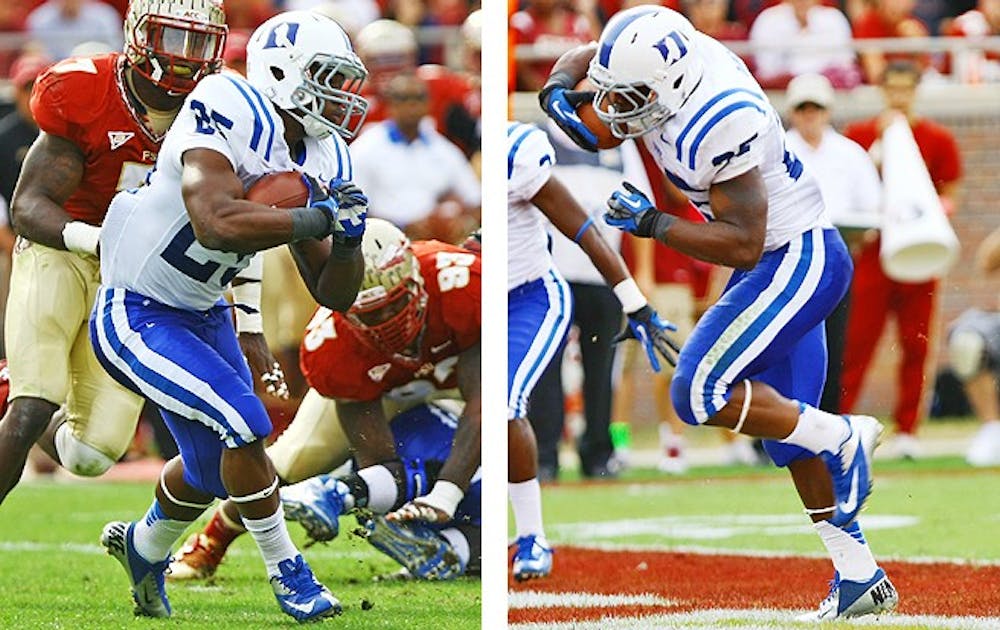Duke will enter the 2013-2014 season facing a problem it has not yet seen in the first five years of the David Cutcliffe era: the Blue Devils have so many running backs, they might not know who to hand the ball off to.
The top six rushers in a unit that averaged more than 125 yards per game last season will be back on the field in the fall, including Juwan Thompson, Josh Snead, Jela Duncan and Shaquille Powell.
“It’s an interesting problem,” Cutcliffe said in regards to who would get the majority of the carries. “It’s a good problem. As a group, it might be the best group I’ve had. Certainly the best group we’ve had since we’ve been here.”
Not only will the Blue Devils have depth at the running back position, but also diversity of ability. Each of the top-four backs brings something different to the offensive side of the ball.
Thompson, the lone senior of the group, has rushed for 896 yards during his three years, averaging 4.3 yards per carry for his career. A multi-purpose athlete, Thompson has also caught 49 balls for 351 yards and three touchdowns in his first three seasons. He is perhaps the most complete of all Duke’s running backs—he can pass block, run block, line up in the slot and catch the ball and even play special teams.
Snead, a junior, is the team’s home run hitter. After redshirting for the 2011 season, Snead returned for his second year of eligibility to rack up 496 yards on the ground, averaging just more than five yards per carry. Snead’s premier performance came in the Belk Bowl loss to Cincinnati, when the junior rushed for 107 yards on 17 attempts.
To go along with the experience of Snead and Thompson will be the talented sophomores Duncan and Powell. Duncan, although young, led the team in total rushing last year with 553 yards on the ground. As a true freshman, Duncan used his punishing downhill style to run for four touchdowns, but also showed his versatility by racking up 19 receptions.
Powell, who saw limited playing time at running back last year, has been performing at a high level all spring. The Las Vegas native rushed for just 93 yards on 28 carries last season, but led the Duke ground attack in its April 3 scrimmage with 48 yards on eight carries.
“What Shaq is doing is not surprising to me at all,” Cutcliffe said. “He’s had a great year of lifting and getting stronger…. He’s got great vision, great feet and great cutting ability. He’s really a truly complete back.”
With a stable of talented running backs like the Blue Devils have not seen in years, the team’s offensive dynamic could see a makeover.
Duke has spent much of its early spring practices focusing on a zone-read package—a fast-paced shotgun style offense designed to give running backs and quarterbacks freedom to read the offensive line’s movements and burst through gaps or cut back across their blockers.
After running a pass-heavy spread offense for most of Cutcliffe’s tenure, increasingly focusing on the zone-read should make the Blue Devils into a two-dimensional offensive threat unlike in past years, when defenses could play pass-first defense and mostly disregard the ground attack.
With the graduation of senior quarterback Sean Renfree and wideouts Connor Vernon and Desmond Scott, most of Duke’s offensive experience next season will rest with its talented core of backs and its offensive line, which returns four-of-five starters.
“We know we can count on them up front,” Snead said. “They know what they’re supposed to do, and they’ve been in the system multiple seasons so they know what to expect going into a game. It’s really huge to know that we can count on them to run the football, and they can protect [quarterback Anthony] Boone in the passing game.”
The Blue Devils will be adding another crucial element to their offensive arsenal next year—a mobile quarterback.
Redshirt junior Anthony Boone is currently slated as the starter, with redshirt freshman Thomas Sirk filling the backup position. Unlike Renfree, a pocket passer, Boone is much more active in the run game and will fit in well with the zone-read offense. The Monroe, N.C. native ran for 86 yards and a pair of touchdowns last season on 26 carries.
Redshirt junior Brandon Connette also took snaps at quarterback last year and rushed for eight touchdowns on just 41 carries, most of which came in the red zone.
With all the talent at running back, as well as mobile quarterbacks in Boone and backups Sirk and Connette, Cutcliffe and his offensive coordinator could face a challenge in distributing carries throughout the season, assuming everyone remains healthy.
“Whoever has the hottest hand is going to get the carries when it comes to the end of the game,” Snead said. “We are competitive guys, so we feel like we can all go out there and be the man.”
For newly promoted running backs coach Re’quan Boyette, who graduated in 2009 after racking up more than 1,200 yards in his career as a Blue Devil, the talent at his position will provide a challenge in distributing the workload. But the two-time Duke captain is ready for the task.
“That’s the best problem and the worst problem that I have,” Boyette said. “Every single one of these guys could go play anywhere in the country, hands down, and be a big contributor. But we have all of them here. That’s the best part about it.”
Get The Chronicle straight to your inbox
Signup for our weekly newsletter. Cancel at any time.

